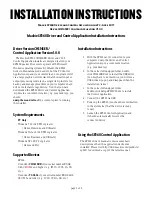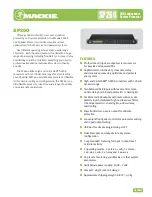
Installation and set-up
Clock
generator pin
Description
RC200 FPGA pin RC203 FPGA pin
GCLK2P
CLKUSER. Clock used to feed the FPGA.
Y12
AB14
GCLK5P
24.576MHz clock. Used to feed video input
and audio chip.
B11 D13
GCLK6S
25.175MHz clock. Used to feed VGA output
(640 x 480 at 60Hz).
C11 E13
GCLK0P
27MHz video input clock.
AB12
AD14
GCLK1P
50MHz crystal clock. This is used to feed
the CPLD.
E12 G14
GCLK7S
Expansion clock 0
AA11
AC13
GCLK5S
Expansion clock 1
W11
AA13
CLKCTRL V19
Y21
TV clock rates
The clock generator also produces 14.318MHz and 17.7MHz clocks for the RGB to PAL/NTSC encoder.
You can select between these values using the CLKCTRL signal (pin 15 on the clock generator).
FPGA clock: CLKUSER
CLKUSER has a default value of 133MHz. You can change the default value of CLKUSER by
programming the PLL from the FPGA or parallel port.
4.8.1 Programming the PLL via the parallel port or FPGA
The RC200 PLL chip can be soft programmed by either the FPGA or the parallel port. It reverts to factory
settings on a power on reset. The PLL chip supports a form of I
2
C.
If you are programming from the parallel port, the FPGA should be disabled by asserting nPROG if there
is any chance of it interfering with the programming of the PLL.
2
If you program any of the clocks apart from CLKUSER, you could stop the devices from
working, or damage them.
Programming the PLL from the parallel port
Three bits in the CPLD are used during PLL programming. The state of the data line can be monitored at
any time by reading bit 7 from address 3. The clock line for the data is bit 6 of address 3. The bit for
writing zeros is bit 7 of address 3. The data line is pulled up by a resistor, so by writing 3[7]=1 a one will
be written. When data is to be read from the PLL chip, bit 7 of address 3 should be set to 1 so that the
PLL chip can pull the data line to zero if required.
except that the
registers are at a different address in the CPLD. The data line is monitored by reading bit 7 from address
1 and the clock line for the data is bit 6 of address 0. The data line is bit 7 of address 0.
Programming the PLL from the FPGA
Programming the PLL from the FPGA is the same as programming from the parallel port
www.celoxica.com
Page 25
















































